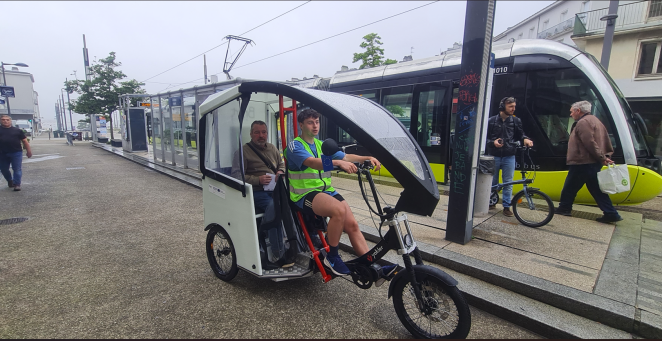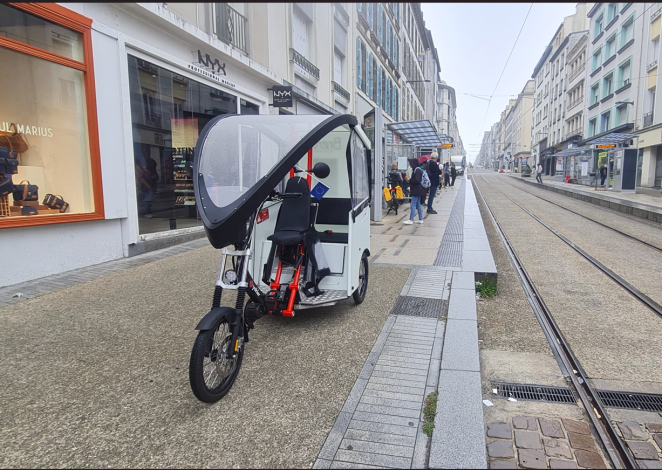When works on the second tram line in the city centre of Brest disrupted the smooth operation of the first tram line over the summer, a small but impactful operation merged to ensure that people with reduced mobility could still get around. We spoke with Nicholas Hastings, an IVY volunteer of Brest metropole, who helped the Bapav association to experiment the Velo&co service in a new framework, about how it worked, the challenges they faced, and what it meant for the community.

What was the idea behind the project?
Nicholas Hastings :
For two months, part of the tram line between Château and Jean Jaurès was closed for works, leaving more than one kilometre of discontinuity through the city centre. Users were invited to take a regular bus line that filled the gap, but they neither stopped directly next to the tram stops nor served the Siam sector, where we have intervened a lot. The project aimed to help people with reduced mobility (PRMs) move across this area, which would have otherwise been difficult for them to access.
So, we used our tricycles, adapted to transport PRM. It wasn’t just about filling the gap in public transport, but about making sure everyone could still access the city during the works.
What did Velo&co’s role look like?
Nicholas Hastings:
The Velo&co service is not only offered during disruptions. They also run services at the Bellevue market, taking people to and from their homes. Even though other trips are made in different parts of Brest, most users are based in Bellevue and it’s a key part of their work.
In Brest, during the tram closure, we operated every Tuesday: two hours in the morning and two in the afternoon. Together with 3 volunteers from Bapav, we carried out a total of 128 trips (16 trips/day) and transported 186 people.

How did users respond?
Nicholas Hastings:
Honestly, everyone was really happy. We met a lot of people who were curious and interested in the service even if they did not test it. But those who tried it were enthusiastic. By the end of August, some had built a routine: every Tuesday they expected me, and I got to know them personally. That kind of connection is what makes you proud of the work.
It wasn’t just transport from one point to another. People would talk about their day, their lives, their stories. People with reduced mobility are often at a higher risk of being isolated, so the social contact was just as important as the ride itself. It wasn’t just a transport service, but a way of giving people the chance to enjoy the company of others.
What challenges did you face?
Nicholas Hastings:
Bureaucratically, it was quite straightforward. We were in direct contact with Bibus, the local transport operator, and they supported the experiment.
The real challenge was communication. At the beginning, people didn’t know what the service was. We had posters at both tram stations, but often we had to approach people directly. Word of mouth worked best. Mediators of Bibus also helped spread the word.
Another challenge is that many people who might benefit most—especially those unable to even reach the tram station—weren’t reached by the service. That’s a harder gap to address.

What did you personally take away from this project?
Nicholas Hastings:
At first, I thought it would just be like a small taxi service: a simple trip from point A to point B. But it became much more than that. It was a social service as much as a transport one.
Some people even refused rides, saying: “It’s very nice of you, but I need to walk.” That showed me how aware people are of the benefits of walking for their health. On quieter days, I sometimes transported younger people too, as the service is open for anyone who needed it. That reinforced an important point: accessibility measures don’t just benefit one group; they make life easier for everyone.
What are the next steps?
Nicholas Hastings:
For now, we’ll continue the regular activities with Velo&co, helping people get to the market, the doctor, or shopping. As for extending the tram-related service, we’ve only just started discussing it.
But one thing is certain: disruptions like tram works will happen again, and this kind of service has proven to be useful, appreciated, and impactful.
Final reflections
Even small-scale experiments like this one are the perfect example of how increasing accessibility is a great solidifier of social cohesion. It proves that mobility is about more than infrastructure: it’s about people, connections, and ensuring that everyone has a way to participate in urban life. This is exactly what SMALL aims to do.
